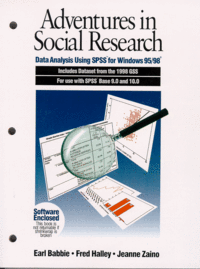

![]()
![]()

To the reader conversant with SPSS the book does not provide as detailed or as comprehensive guidance as the Norusis (1999) Guide. Nevertheless it forms a useful workbook to the inexperienced reader to enable him or her to produce descriptive and inferential analysis of the data obtained. It combines the steps required using program 'dialogue boxes' to produce meaningful output, as well as giving some insight into the statistical measures of association such as Lambda, Gamma, Pearson's r, Regression, Independent Sample-t test. Using the workbook the reader should soon be able to analyse the variables given; and also recode or to combine them in such a way as to create indices that bring new levels of association to light.
Given the constraints and aims of the book it is perhaps not surprising that the authors provide little discussion on the use of syntax that equally may be used to reproduce the results; or some of the more esoteric functions available within the SPSS program. The authors perhaps considered that these functions were best left until a later stage when the student or researcher was fully engaged by SPSS, and more conversant with the basic procedures.
The book has an extensive glossary and the end of each practical chapter contains a summary of the main points, key terms employed and review questions on the main aspects discussed. Most useful too is a list of the main SPSS Commands introduced in each chapter and SPSS lab exercises. These are also accompanied with answers that enable the reader to test the extent to which he or she has properly understood and applied the processes described.
The book comes with a diskette (with three data files) containing variables drawn from the American General Social Survey of 1998 that can be used to reproduce the results discussed in each chapter. The format and presentation of the book makes for relatively easy reading. However, this book just considers SPSS Version 9. As Version 10 has been available since mid -1999 and modifies the data windows available (and by implication inputting of raw data) the question arises whether the workbook offers good value for money. Although the authors only make passing reference to Version 10, nevertheless the broad purpose and usefulness of this book as a basic teaching aid remains.
Despite, or perhaps because of, the value laden concepts that are used throughout the book's exercises it does succeed in living up to its title and stimulating the reader to tease out relationships that might underlie the variables contained in the data. It demonstrates that 'bald' statistics may conceal a wealth of meaning. The aim of the book was to provide assistance to an audience at a variety of levels but at £27.00 seems more valuable to the student or researcher with little knowledge of SPSS who wishes to develop their expertise.
Tom Daly
University of Surrey